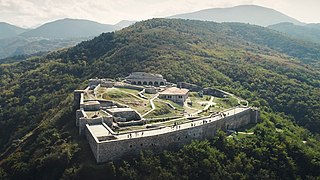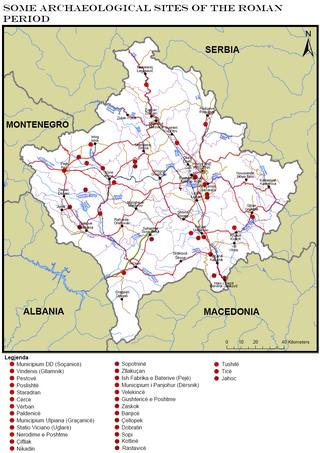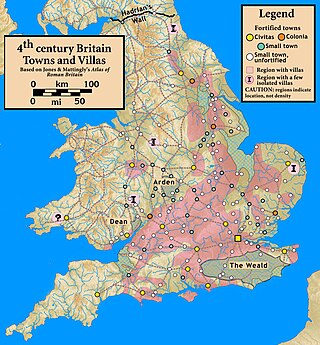
Sabratha, in the Zawiya District of Libya, was the westernmost of the ancient "three cities" of Roman Tripolis, alongside Oea and Leptis Magna. From 2001 to 2007 it was the capital of the former Sabratha wa Sorman District. It lies on the Mediterranean coast about 70 km (43 mi) west of modern Tripoli. The extant archaeological site was inscribed as a UNESCO World Heritage Site in 1982.

Ulpiana was an ancient Roman city located in what is today Kosovo. It was also named Justiniana Secunda. Ulpiana is located in the municipality of Graçanicë, 12 km southeast of Prishtinë. The Minicipium Ulpiana or Iustiniana Secunda was proclaimed an archaeological park under the permanent protection of Kosovo by the Kosova Council for Cultural Heritage in 2016. The archaeological park has an area of 161.10 hectares and a surrounding protection zone of 96.23 hectares. Ulpiana was among the largest settlements in the Balkans in late antiquity.

Prizren Fortress is a hilltop fortification in Prizren in Kosovo. It overlooks the Prizren River which flows through Prizren, which developed around the fortress. The site of the fortress of Prizren has seen habitation and use since the Bronze Age. In late antiquity it was part of the defensive fortification system in western Dardania and was reconstructed in the era of eastern Roman Emperor Justinian. Byzantine rule in the region ended definitively in 1219–20 as the Serbian Nemanjić dynasty controlled the fort until 1371.

Municipium Dardanorum or Municipium Dardanicum was a Roman mining town whose life lasted from the 2nd to the 4th century AD, that was connected with the workings of. Its remains are situated in the northern part of Kosovo, located approximately 27 kilometres north of Mitrovica, about 65 km northeast of Ulpiana in the Municipality of Leposavic, localized in the village of Sočanica in the province of Moesia Superior, later the Roman province of Dardania.

Megiddo church, near Tel Megiddo, Israel, is an archaeological site which preserves the foundations of one of the oldest church buildings ever discovered by archaeologists, dating to the 3rd century AD. The ‘Megiddo Church’, as the room became known, was dated to circa 230 AD on the basis of pottery, coins, and the inscriptional style. The site’s abandonment, circa 305 AD, is evident in the purposeful covering of the mosaic, and relates well to the crisis of 303 AD, when the Christian communities of Judea experienced the Diocletianic Persecution.

Vendenis or Vindenis was an ancient city in Dardania in Kosovo. Among three road stations that were constructed in Dardania during the Roman Period, Statio Vindenis, is one of the identified stations. This archaeological site is set at the area of the village of Gllamnik, Municipality of Podujeva. The site is located approximately 5 km south, southeast from Podujeva.

A Roman mosaic is a mosaic made during the Roman period, throughout the Roman Republic and later Empire. Mosaics were used in a variety of private and public buildings, on both floors and walls, though they competed with cheaper frescos for the latter. They were highly influenced by earlier and contemporary Hellenistic Greek mosaics, and often included famous figures from history and mythology, such as Alexander the Great in the Alexander Mosaic.

The Roman heritage sites in Kosovo represent a multitude of monuments of material and spiritual culture, which reflect the Roman period in this region. Among them, a special place is occupied by those that represent the development of art, such as the plastic monuments that are more frequent, and at the same time occupy an important place, because with the presentation of figures in relief and with numerous inscriptions they speak to us enough for this period.

Part of a series of articles upon Archaeology of Kosovo

Part of a series of articles upon Archaeology of Kosovo

Recorded traces of the Vërban archaeological site, inform us a lot about site selection for the settlement building during the Roman times. The site is set close to Klokot, in an alluvial terrace stretched along the Morava river flow, an area known for the fertile land and near the warm thermal mineral waters spring. One of the most interesting accidental archaeological discoveries is a sculpture found near the Banja e Kllokotit, a masterpiece of the Dardanian art, presenting an example of the distinguished autochthonous sculpturing art, of advanced artistic creation. It is sculptured in qualitative marble, and reflects a figure of a high-toned Dardanian lady.

Part of a series of articles on Archaeology of Kosovo

Viciana or Station Viciano was a Roman road station of unclear location, somewhere in Kosovo field.

Part of a series of articles upon Archaeology of Kosovo

Part of a series of articles upon Archaeology of Kosovo
Nerodimë e Poshtme or Donje Nerodimlje is an archaeological site and village situated west of the city of Ferizaj, Kosovo. Several archaeological trenches were investigated at this location in 1988.
The strategic position of the region of Mitrovica in the middle of two great rivers Ibar and Sitnica and its mineral wealth in Albanik, made this location populated since prehistoric period. This region was populated by Illyrians, respectively members of the Dardan tribe. The first data for the archaeological sites in the region of Mitrovica, begin with the researches of Sir Artur John Evans, who was the first to pinpoint the Roman town of the Municipium Dardanourm. In the archaeological sites of the region of Mitrovica were found traces and objects from different periods such as; Neolithic, Roman, late antiquity and medieval period. Objects and figurines include: fortress vestiges, necropolis, Terpsichore figure, statues, sarcophagus, altar, jewelry, etc.
Kosovo has a rich heritage in archaeology, however the field suffers from a lack of substantial institutional research. Since prehistory, the advantageous geostrategic position and abundant natural resources of the area have been suitable for the emergence of life. This is shown by the traces of hundreds of archaeological sites discovered throughout the country, displaying the abundant archaeological legacy.

The Rutland Roman villa is a Romano-British villa site in Rutland, England. The site was listed as a scheduled monument by Historic England on 23 November 2021. The villa includes the first example of a mosaic in Britain which depicts scenes from Homer's Iliad.
This page lists significant events of 2022 in archaeology.











